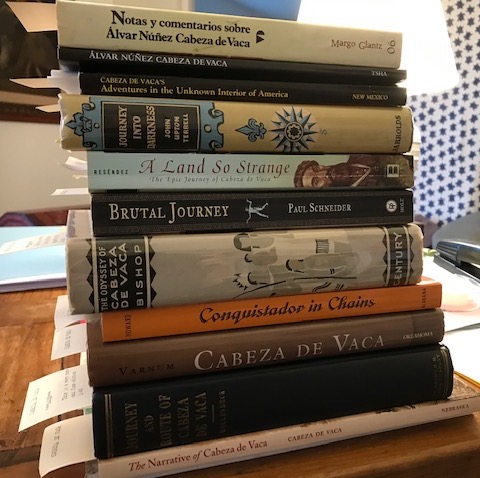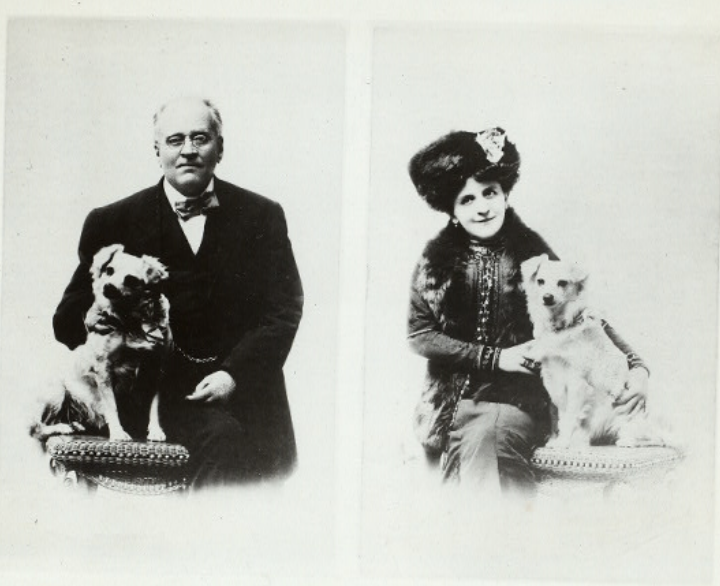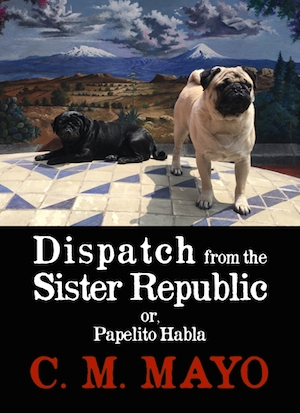
This blog posts on Mondays. This year, 2021, I am dedicating the first Monday of the month to Texas Books, in which I share with you some of the more unusual and interesting books in the Texas Bibliothek, that is, my working library. Listen in any time to the related podcast series.

Yes, that most memorable of conquistadors’ names, Cabeza de Vaca, means Cow Head. Alvar Núñez Cabeza de Vaca was, among many things, the author of the first printed book on what is now the American Southwest and the great state of Texas— back when it was terra incognita, the 1500s. I have already written about Cabeza de Vaca and his book, La Relación, in a longform essay about the Mexican literary landscape, “Dispatch from the Sister Republic or, Papelito Habla.”
Now that I’m writing about Far West Texas, Cabeza de Vaca pops in again, but where in Far West Texas was he, exactly? Towards answering that question, for my working library, which I have dubbed the Texas Bibliothek, I’ve accumulated a hefty stack of Cabeza de Vaca biographies, histories, and translations of his La Relación. (I do read Spanish, and in fact I’m a translator myself, however I specialize in contemporary Mexican writing, not 16th century Spanish, large chunks of which can float by me like so much Gabbahuaque.) The consternating thing is, in these various tomes the various routes mapped out for Cabeza de Vaca’s travels differ wildly.
As recounted in La Relación, Cabeza de Vaca’s travels encompass, from southern Spain, the Canary Islands, Cuba, Florida, the Galveston area, his enslavement in the general region we call South Texas and what is now northern Mexico, also his trek through Far West Texas, and thence a jog southwest to the Pacific coast, where he was rescued by Spanish slavers, and on to Mexico City-Tenochtitlan, where he was received by Hernán Cortez, conquistador of the Aztec Empire, the Marqués del Valle, himself. (Subsequently, after writing his Relación, Cabeza de Vaca was sent to Argentina, and from there, for being much too nice to the Indians, returned to Spain in chains.)
There is indeed a library’s-worth to say about the life and times of this most unusual conquistador and his fantastic travels and ghastly travails.
THE TWO EDITIONS, 1542 and 1555
A first edition of La Relación appeared in Zamora, Spain in 1542; a second, slightly different, edition in 1555. The latter is available for viewing online at the Witliff Collections— have a look here. To bamboozle matters, some English translations are of the 1542 edition; others of the 1555; some a medley of both.
Of the differences between the two editions, in his introduction to the Penguin Classics edition of the Bandelier translation (discussed below), Ilan Stavans says:
“Whereas the [edition] of 1542 is an attempt to show his courage and achievements to Charles V, the 1555 edition seeks to present the author in a good light so as to cleanse his reputation from charges against him after his forays in South America. Therein lies the difference: the first is a report, the second is an engaging, persuasive act of restoration.”
In addition there was a testimony known as The Joint Report given by Cabeza de Vaca and the other two Spanish survivors of the Narváez Expediton upon their return. The original of The Joint Report has been lost, however a partial transcription was made by historian Gonzálo Fernández de Oviedo (1478-1557), and included in his Historia general y natural de las Indias— a verily massive collection of 19 books not published in its entirety until (not a typo) 1851. There is a good website in English on Oviedo’s Historia general y natural at Vassar which you can view here. The notable biographies of and narrative histories about Cabeza de Vaca also incorporate the Joint Report from Oviedo. (I’ll be doing a post on some of those works next first Monday.)
NOTES ON SELECTED ENGLISH TRANSLATIONS OF CABEZA DE VACA’S LA RELACIÓN
SAMUEL PURCHAS, 1625
The first English translation, by Samuel Purchas, came out in 1625—nearly a century later— sandwiched into a collection of exploration narratives entitled Purchas His Pilgrimes. You can read about that at the Witliff Collections Cabeza de Vaca website. Purchas’ source was the Italian translation of 1556, which explains his calling the author “Capo di Vaca.” Not in my working library, last I checked. If you ever happen to come upon an original edition of Purchas His Pilgrims on offer, and perchance have the clams to buy it, I would suggest that, forthwith, you donate it to a worthy institutional library.
THOMAS BUCKINGHAM SMITH, 1851 and 1871
Astonishingly, no English translation was made directly from the Spanish original of Cabeza de Vaca’s La Relación, until Thomas Buckingham Smith‘s in 1851, of the 1555 edition. That it would take over three centuries for a stand-alone English translation of such a major work in the history of the Americas to appear is, in itself, telling— as was the historical moment: the wake of the 1848 Treaty of Guadalupe, which ended the US-Mexican War and considerably expanded the territory of the United States at the expense of its sister Republic.
The New York Historical Society, which has Smith’s papers, offers this brief, albeit most interesting, biographical sketch of the far-traveling translator:
“Thomas Buckingham Smith was a lawyer, diplomat, antiquarian, and author. Smith was born on October 21, 1810 on Cumberland Island, Georgia. The family moved to St. Augustine, Florida in 1820, when Smith’s father was appointed U.S. Consul to Mexico. Smith attended Trinity College in Hartford, Connecticut and earned a degree from Harvard Law School in 1836. Following graduation, Smith worked in the Maine office of Samuel Fessenden, a politician and abolitionist. He returned to St. Augustine in 1839 and served as a secretary to Robert R. Reid, governor of the Territory of Florida from 1839-1841. Smith served as a member of the Florida Territorial Legislative Council in 1841. He married Julia Gardner of Concord, New Hampshire in 1843.
“Throughout his life, Smith was a devoted student of North American history, specifically Spanish colonialism and Native American cultures and languages. In order to further his studies, Smith lobbied U.S. government officials for diplomatic appointments abroad. He was successful in obtaining positions in the U.S. embassies of Mexico (1850-1852) and Spain (1855-1858).
“While abroad, Smith actively purchased, transcribed and translated manuscripts related to the Spanish colonization of North America. Smith also supplemented his income by selling rare books and manuscripts to collectors in the U.S., including Peter Force, an editor and politician, whose collection was purchased by the Library of Congress in 1867. During the 1850-1860s, Smith translated and edited several publications, including Colección de varios documentos para la historia de la Florida y tierras adyacentes (1857), A grammatical sketch of the Heve language (1861), Narratives of the career of Hernando de Soto in the conquest of Florida (1866), and Relation of Alvar Nunez Cabeca de Vaca (1871).
Smith died in New York City in 1871 and was buried in St. Augustine.
Note that the New York Historical Society biography is mistaken: A first edition of Smith’s translation of La Relación appeared in 1851; the second edition, edited by J.G. Shea, was published posthumously in 1871. I am sorry to say that I have not yet seen a copy of this translation; I will have to remedy that. I note that inexpensive reprints are widely available.
MRS. FANNY BANDELIER, 1905

Mr and Mrs Bandelier, she the esteemed translator of Cabeza de Vaca’s Relación. From the NYPL archive (which notes that this image can be freely used).
This second translation of La Relación– from the 1542 edition– was made by Mrs. Fanny Bandelier, and originally published in 1905 as The Journey of Alvar Nunez Cabeza de Vaca. Mrs. Bandelier’s translation held its ground for many decades. According to Cleve Hallenbeck, in his Journey and Route of Cabeza de Vaca, published in 1940:
“Of the two English translations I, in common with nearly all other students, prefer the Bandelier. The Smith translation was admittedly defective, and Smith was engaged in its revision at the time of his death in 1871. It was the need for a more accurate translation that prompted Mrs. Bandelier to undertake the task.” (p.24)
Cyclone Covey, on the other hand, has this to say about the Smith and the Bandelier, in his introduction to his 1961 translation (notes on that below):
“The translation that follows has been checked against both of these and is deeply indebted to the more literal Smith version.”
Go figure.
The Briscoe Center at University of Texas, Austin has a collection of documents transcribed from those in the Archivo General de las Indias in 1914-1917 by Fanny and her husband, Adolphe Francis Alphonse Bandelier. From that website, we have a biographical note for Mr. Bandelier but, alas, not Mrs:
“Adolph Francis Alphonse Bandelier (1840 – 1914) was an American archaeologist after whom Bandelier National Monument in New Mexico is named. Bandelier was born in Bern, Switzerland, and emigrated to the United States in his youth. After 1880 he devoted himself to archaeological and ethnological work among the Indians of the southwestern United States, Mexico and South America. Beginning his studies in Sonora (Mexico), Arizona and New Mexico, he made himself the leading authority on the history of this region, and — with F. H. Cushing and his successors — one of the leading authorities on its prehistoric civilization. In 1892 he abandoned this field for Ecuador, Bolivia and Peru, where he continued ethnological, archaeological and historical investigations. In the first field he was in a part of his work connected with the Hemenway Archaeological Expedition and in the second worked for Henry Villard of New York, and for the American Museum of Natural History of the same city.”
Says Hallenbech, p. 24:
“[Mrs. Bandelier] was a recognized Spanish scholar, and Adolphe F. Bandelier, who wrote the introduction and annotated the text, certainly subjected the work to the closest scrutinity; some of his notes lead one to believe that he actively participated in the translating. His qualifications for such work are widely recognized.”
Well, ring-a-ling to Gloria Steinem!!
My much marked-up copy of the Bandelier translation is a Penguin Classics paperback edition of 2002 with an introduction by Ilan Stavans, revised and annotated by Harold Augenbraum, shown here:

CYCLONE COVEY, 1961
Not until 1961, with Cyclone Covey’s, did another complete translation of La Relación appear, this one under the title Cabeza de Vaca’s Adventures in the Unknown Interior of America. His translation, Covey writes in his preface, “is deeply indebted to the more literal Smith translation,” and he consulted both the 1542 and the 1555 editions. In the afterword professor William T. Pilkington calls Covey’s “the most accessible” translation for the present-day reader. It is moreover, “thoughtful and balanced, avoiding an archaic tone as well as twentieth-century colloquialisms.”
My copy of the Covey is a 1997 University of New Mexico Press reprint, shown here:

Cyclone Covey, by the way, is also the author of a book about a Roman Jewish colony in Arizona in the time of Charlemagne—you read that right. I’ve yet to read it— the title is Calalus—but it’s extremely rare, although I delightedly note that his son has just this year, 2021, made a print-on-demand facsimile edition available on amazon. Covey had few adherents to his Romans-in-Arizona hypothesis, but I give him major points for the courage to stand by his catapult, as it were, and publish Calalus. (And strange as some things may strike me, I always try to remember that the past is a strange and ever-changing country… ) In any event Covey had a long and otherwise distinguished career as an historian at Wake Forest. You can read Covey’s obituary here.
MORE TRANSLATIONS, 1993
Nearing the 400th anniversary of Columbus’ arrival in the Americas, more translations appeared, including Martin A. Favata and José B. Fernández’s The Account: Alvar Núñez Cabeza de Vaca’s Relación (Arte Público Press, 1993) and Frances M. López-Morillas’ Castaways (University of California Press, 1993, edited by Enrique Pupo-Walker).

ROLENA ADORNO AND PATRICK CHARLES PAUTZ, 1999
At present it would seem that most English-speaking Cabeza de Vaca scholars look to the Adorno and Pautz translation of 1999. Leading scholar of the Spanish Conquest Andrés Reséndez, in his A Land So Strange: The Epic Journey of Cabeza de Vaca (Basic Books, 2007), has this to say about the Adorno and Pautz, in his notes (p.251):
“I wish to single out the landmark, three-volume set published in 1999 by Rolena Adorno and Patrick C. Pautz, Alvar Núñez Cabeza de Vaca: His Account, His Life, and the Expedition of Pánfilo de Narváez. This work constitutes yet another edition and translation of Cabeza de Vaca’s Narrative plus—literally—two and a half volumes of “notes.” These volumes have taken our understanding of this survival experience to a new level. The book contains biographical information of the protagonists, a detailed study of Cabeza de Vaca’s genaeology, relevant historical backrgound, and a textual analysis of the different accounts of ghe expedition, among other things. It constitites the single most important source for the present book project. I have also relied on their transcription of Cabeza de Vaca’s Narrative, first published in 1542, and often cite their translations.” (p.251)
The three volume boxed set published by the University of Nebraska Press, which you might be able to consult in a library, or hunt down on Abebooks.com, is an heirloom of a doorstopper, and yep, it calls for serious clams. (Ouch.) I did buy the three-volume set, very belatedly, and I only wish I had started with it because it is indeed the most authoritative translation and history and biography; moreover, Volume I contains the original text of the original 1542 La Relación side-by-side with Adorno and Pautz’s English translation, with notes on the same page.

In addition, I have been working from, and freely penciling in my underlines in Adorno and Pautz’s much less expensive paperback edition of their translation of La Relación, separately published by the University of Nebraska Press. Here’s a photo of my copy of that:

*
Dear writerly reader, if you are looking for a rollickingly good armchair read about Cabeza de Vaca’s North American odyssey, there are two narrative histories I would especially warmly recommend: Andrés Reséndez’s A Land So Strange, and Paul Schneider’s Brutal Journey. I will be talking about these and other narrative histories and biographies in next month’s first Monday Texas Books post.
Next Monday, look for my monthly post for my writing workshop students and anyone else interested in creative writing.
P.S. I welcome you to sign up for an automatic email alert about the next post, should you feel so moved, over on the sidebar.
I welcome your courteous comments which, should you feel so moved, you can email to me by simply clicking here.

A Visit to the Casa de la Primera Imprenta de América
in Mexico City
What the Muse Sent Me about the Tenth Muse,
Sor Juana Inés de la Cruz
Reading Mexico:
Recommendations for a Book Club of Extra-Curious
& Adventurous English-Language Readers
*

My new book is Meteor



